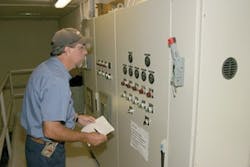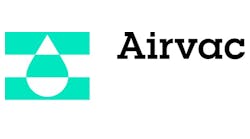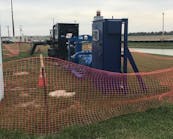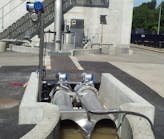Vacuum sewer system helps a Florida town keep operations and maintenance costs to a minimum
“Out of sight, out of mind” is a phrase often used when discussing sewers. That may be true for homeowners, but not for public works directors.
Public works officials have to be aware of sewers at all times. There is maintenance to consider, ongoing operational costs, repairs, cleaning, service complaints, liability and health issues and a host of other considerations. Sewers require at least some attention on a daily basis. They represent a significant part of the public works budget and can consume a substantial amount of man-hours to maintain. Perhaps most importantly, they are vital to the daily operation of a city.
Public works officials in Cedar Grove, Fla., considered all of these factors when they were discussing sewer technology options in 1999 and 2000. When their research was complete, they chose to install vacuum sewers by AIRVAC . The decision to install vacuum sewers has reaped benefits for the city almost every day since the system became operational. That is great news for me, because I became Cedar Grove’s public works director in 2002.
Sewers can consume a lot of a public works director’s time. In Cedar Grove, population 6,500, we have both gravity sewers and vacuum sewers, so we are very familiar with the operation and maintenance of both. When it is time to submit an annual budget, it becomes very clear why my staff and I are so pleased with the performance of the vacuum system. Our vacuum sewer is extremely easy to operate and maintain. It requires less of our time, is more reliable and presents fewer safety concerns. All of these factors save money, which is great for our city and our taxpayers.
If you examine all aspects of sewer operation and maintenance, you see four areas where vacuum sewer technology makes life easier for public works directors: safety, efficiency, reliability and training. In every way, vacuum sewers benefit our operation and make life better for our residents.
Safe Sewers
Safety and liability are areas of concern for every public works director who has to send his personnel into a sewer. With gravity sewers, there are numerous dangers involved in routine maintenance and repair work. Falling into manholes, working in confined areas with the threat of hydrogen sulfide gas, the moving parts and electricity associated with a lift station, traffic hazards, contact with raw sewage and many others all are major concerns. Because of the potential for injury, we always assign two people for gravity sewer maintenance jobs; one man never goes alone.
By comparison, there are very few injury risks associated with vacuum sewers. There are no manholes, no confined spaces and access to the collection lines is typically easy because they usually are buried only 3 to 5 ft deep. The motors and moving parts in a vacuum station are completely self-contained and there is never any contact with raw sewage. We have about 500 vacuum valve pits that are easily accessed at curbside. No special tools are required, and because they operate pneumatically, no electricity in involved.
The safety/liability issue is best illustrated by the fact that we have no problem sending a single workman out to perform vacuum sewer maintenance and repairs. As the person responsible for their safety, I never worry when my staff is working on our vacuum sewers.
Time and Money Savings
Nothing eats up a public works budget faster than salaries and overtime. Also, if you have one aspect of your public works infrastructure consuming your time and money, it takes away from work you could be doing on other city infrastructure.
We have two vacuum sewer stations serving approximately 2,000 homes. We have seven gravity sewer lift stations serving approximately the same number of dwellings. Routine service is required at each station everyday. Servicing each vacuum station takes about 10 minutes. Each lift station requires one hour. In a seven-day week, we spend about 2.5 hours servicing our vacuum stations, compared to 49 hours servicing our lift stations. Also consider that the vacuum station is always clean and odor-free because the sewage is in a contained system, with no leaks and no contact with the sewage. The gravity lift stations put the workmen in contact with sewage. A workman has to open the lift station hatch, clean the floats, add degreaser, exercise the pumps and hose out the wet well. It is a tedious and often dirty job.
Field maintenance for the vacuum system is also easy. There are approximately 500 valve pits and we check them on a rotational basis. It takes one public works staffer about eight working days to service all the pits. The process is fast and easy and requires no special tools, not even rubber gloves. There is never contact with sewage and there are no bad odors. We rarely have field maintenance problems with the AIRVAC system . Last year we had two after-hours callouts for the vacuum sewer. We had 78 callouts for the gravity system, plus many more routine service and maintenance issues associated with the gravity line, and virtually every service job required a crew of two or more workmen.
The gravity sewer collector lines also require regular cleaning with a jet truck. The vacuum lines are self-scouring, so no jet cleaning is necessary. Also, vacuum sewers allow far less storm water and groundwater infiltration into the system, saving costs at the treatment plant. Manholes and lateral connections are notorious for leaks. You eliminate these leaks with a vacuum sewer.
It is also interesting to note that our vacuum sewers require less electricity to operate on a per-connection basis. Gravity sewers cost the city approximately $1.61 per month, per connection. The electrical cost for our vacuum system is only $1.27 per month, per connection.
Calm During the Storm
Cedar Grove is located just a few miles inland of the Gulf of Mexico. As you might expect, we get several major storms every year and the occasional hurricane. Every storm presents the possibility of an electrical power outage. This can be disastrous for sewer utilities. The loss of power shuts down the lift and the vacuum stations. Gravity sewer lines, often filled with rainwater infiltration, quickly back up into homes and businesses, creating a public health nightmare.
Vacuum sewers have the benefit of being closed systems so rainwater cannot infiltrate the lines. Furthermore, a permanent generator located in the vacuum stations can keep the vacuum system operational, whereas we have to shuttle portable generators between lift stations to keep the gravity system functioning.
When electrical power is lost, nearly all of our staff is dedicated to keeping the gravity system running. With the vacuum system, the only thing we have to do is keep gasoline in the generator.
Nice & Easy
Public works directors who have no experience with vacuum technology may think that vacuum sewers are complex systems that require years of specialized training to maintain, but that is not the case. We recently had a new hire that was assigned to service our vacuum sewer system. Within a week he was capable of handling the daily maintenance schedule by himself. He will soon go to Rochester, Ind., for a week of specialized hands-on training. When he returns, he will be capable of handling nearly all aspects of repair and service to the system.
As with all systems, parts occasionally wear out and sometimes vacuum mains are damaged. We have found that replacing vacuum sewer components is easy, largely because the system is amazingly simple and provides easy access to the valve pits, vacuum station and vacuum mains. Repairs typically take only minutes and the component parts are relatively inexpensive. Also, if a vacuum main is broken or punctured, it usually can be excavated and repaired with one to two hours. The repair points also are easy to locate thanks to the monitoring equipment in the vacuum stations.
Having supervised the maintenance of both gravity and vacuum sewers for several years now, I am convinced of the benefits of vacuum sewer technology. It is safe, efficient, reliable and simple to operate and maintain. We hope to expand our vacuum system soon so that our public works department will become even more cost effective. For topographic conditions like we have along the coast, vacuum sewers are by far the best option for sewage collection.
Thomas Voght is the public works director for the town of Cedar Grove, Fla.



